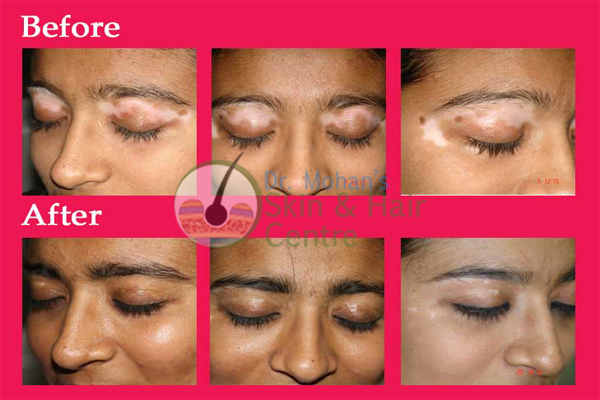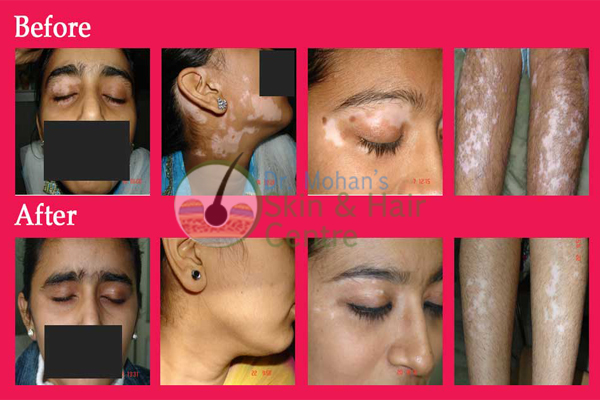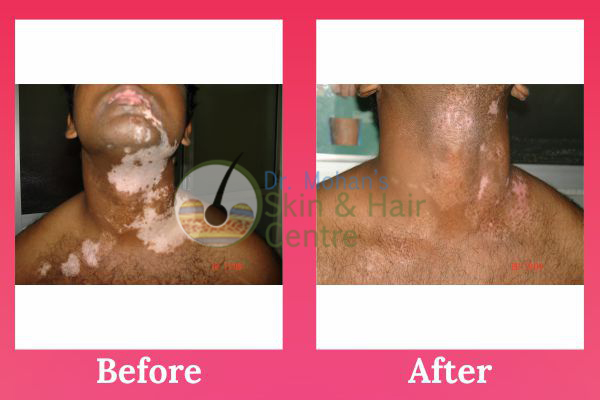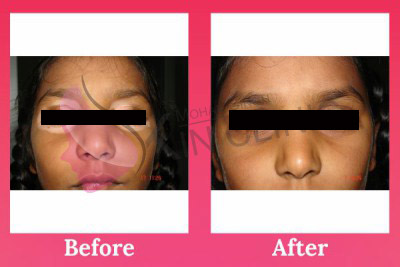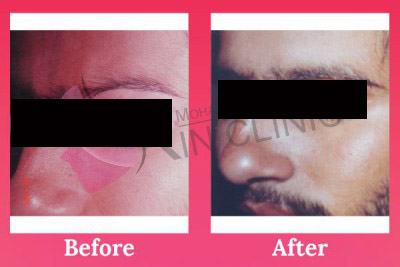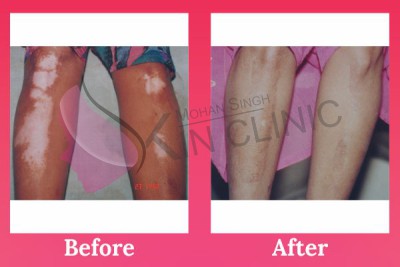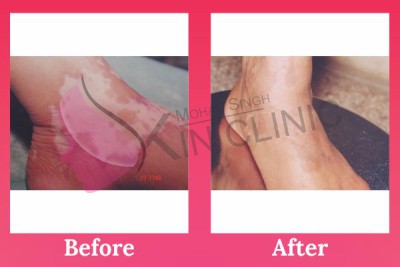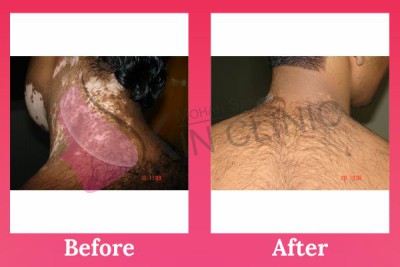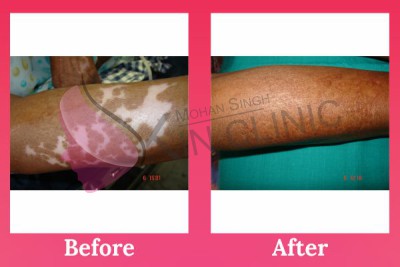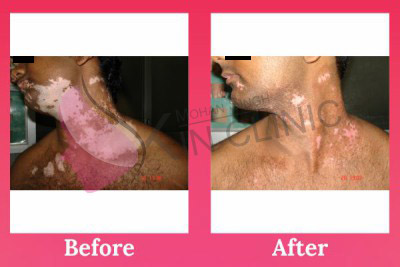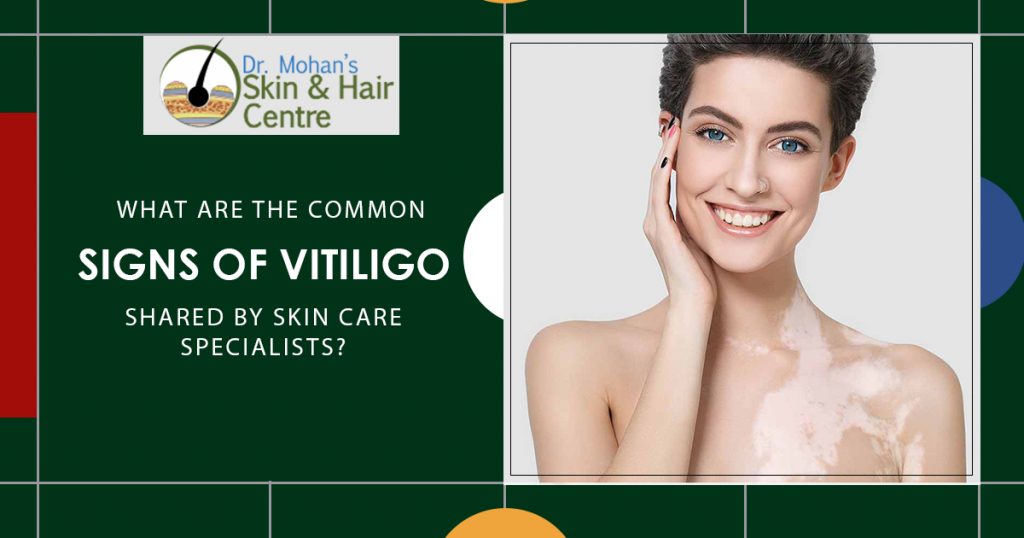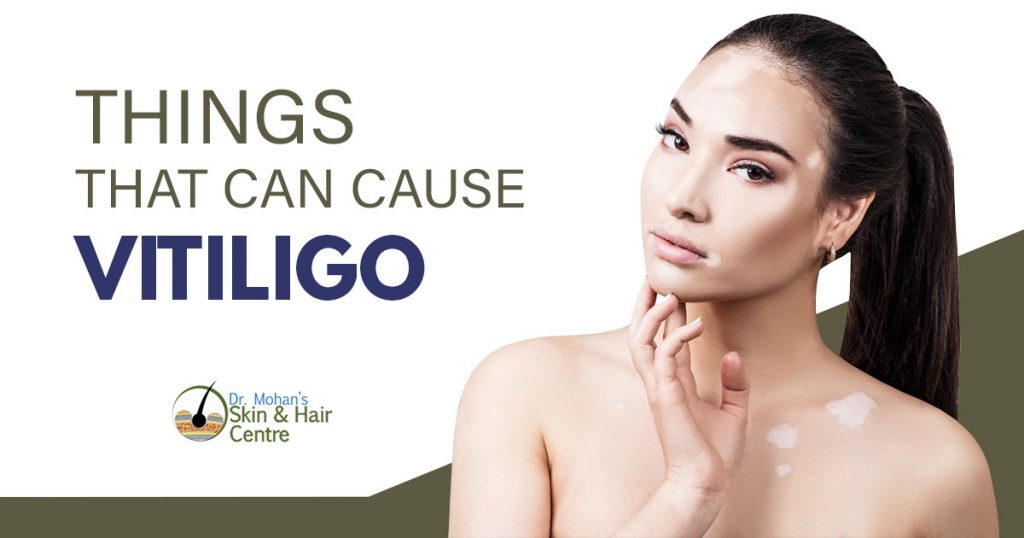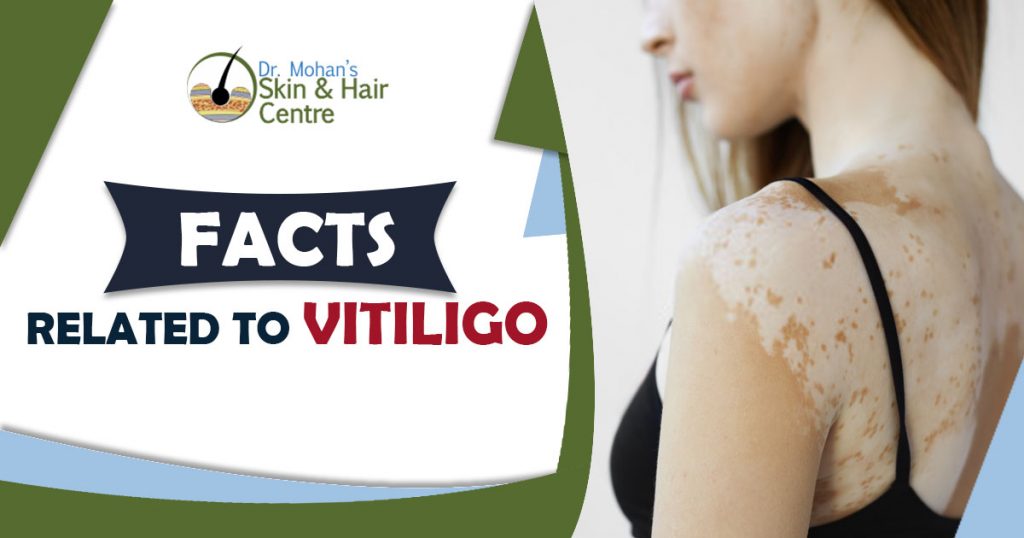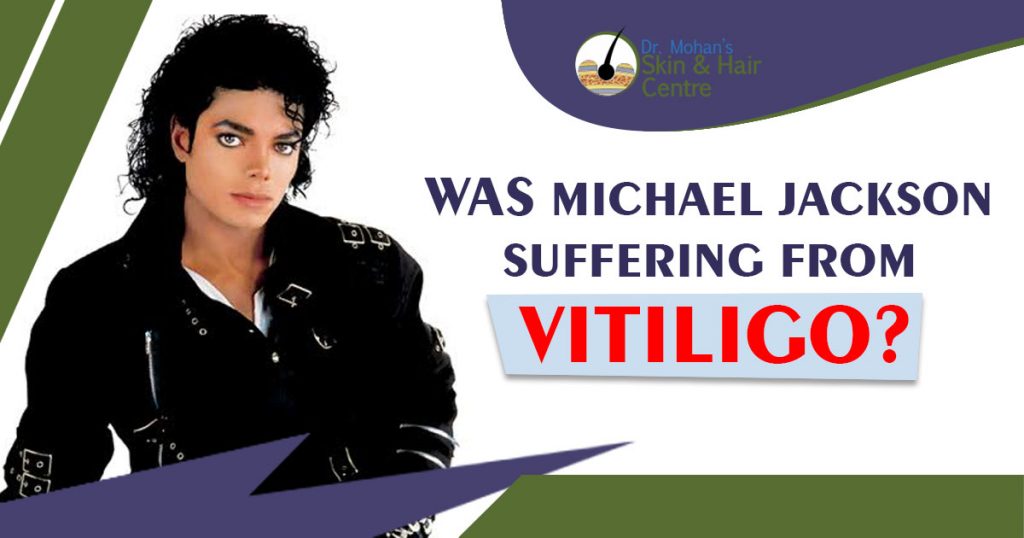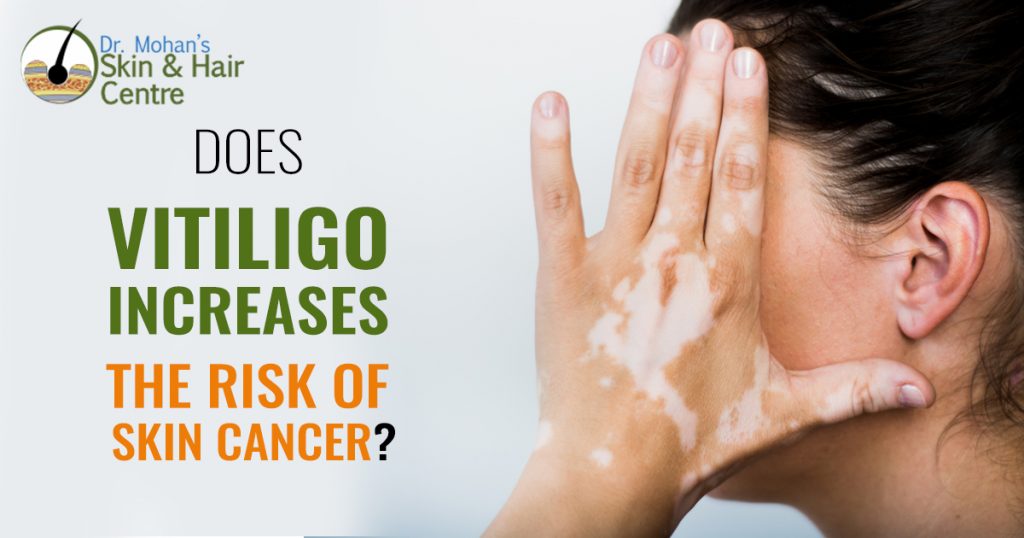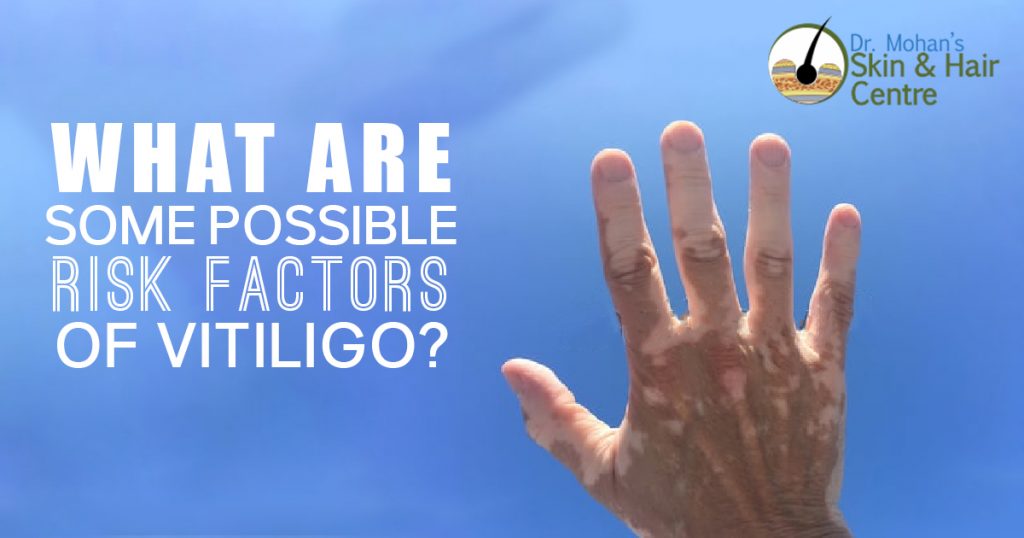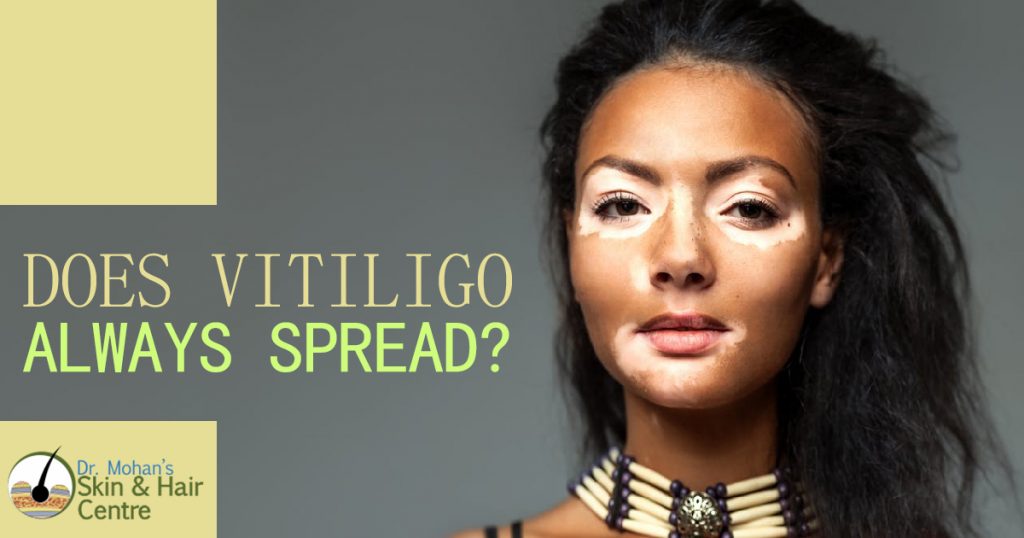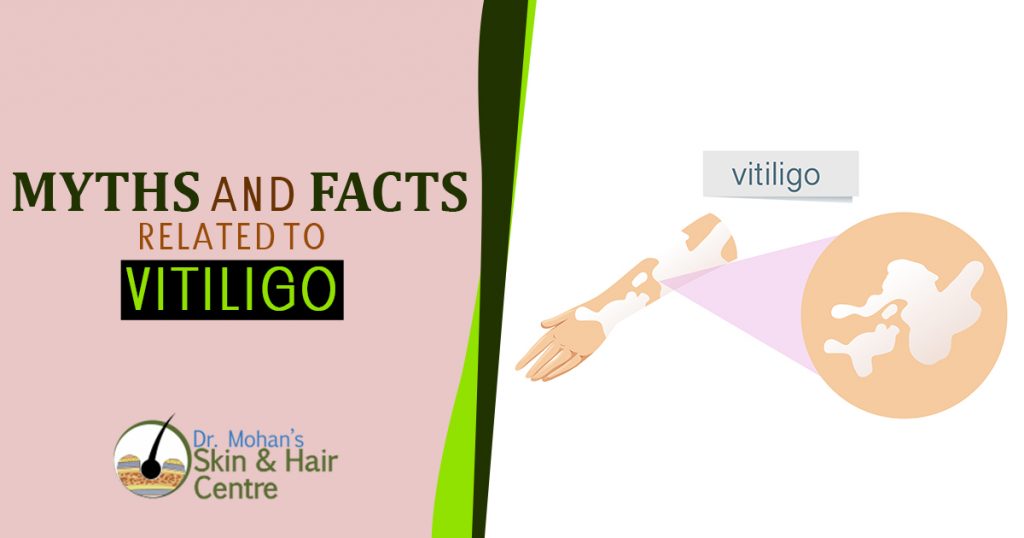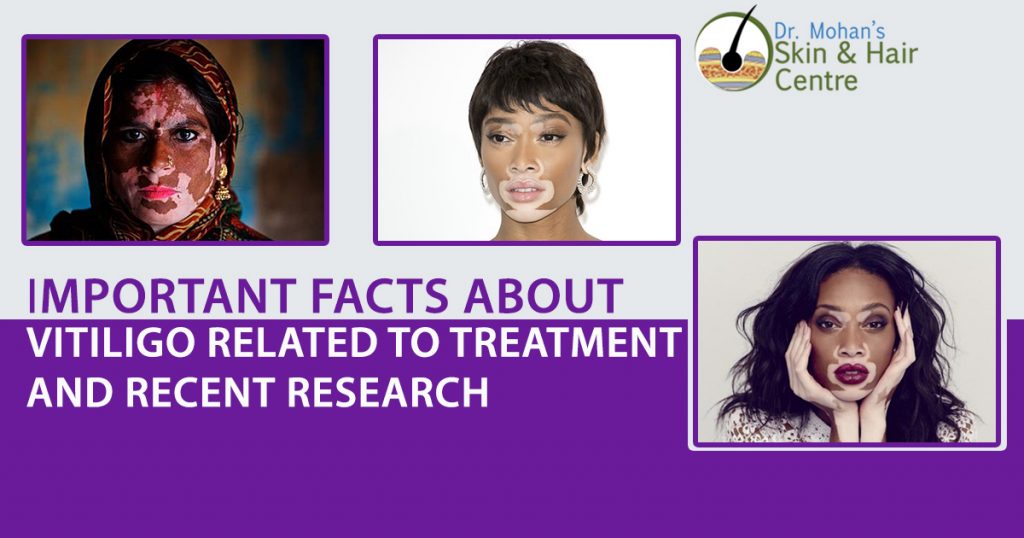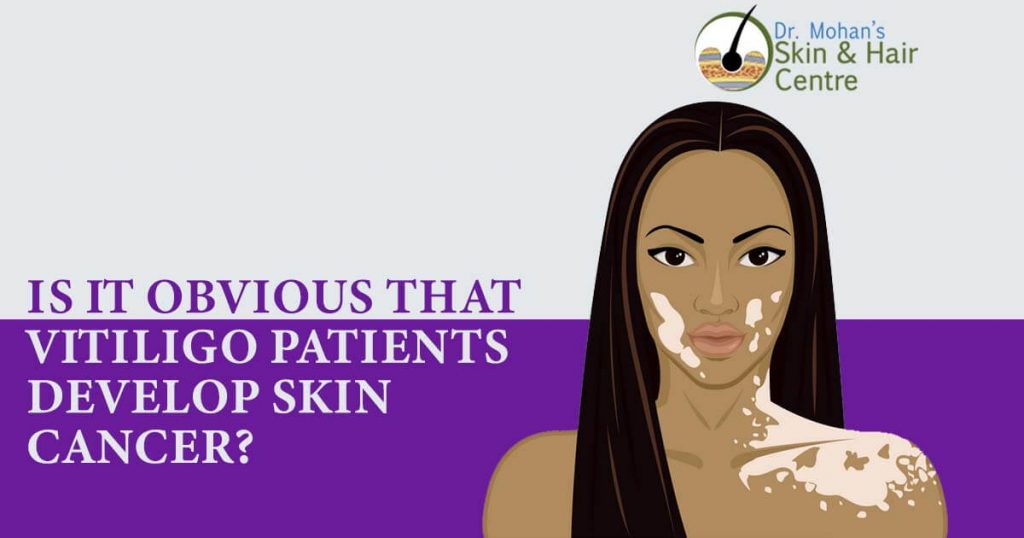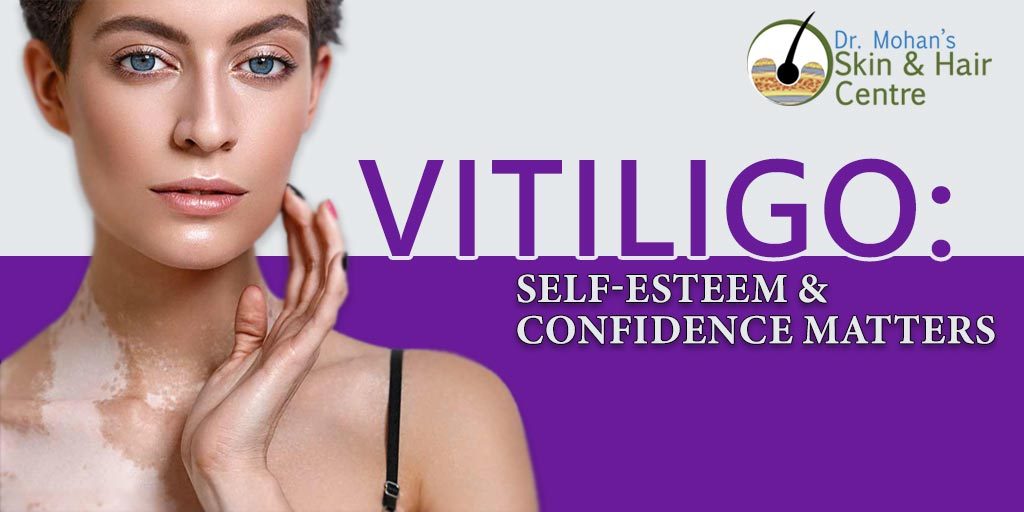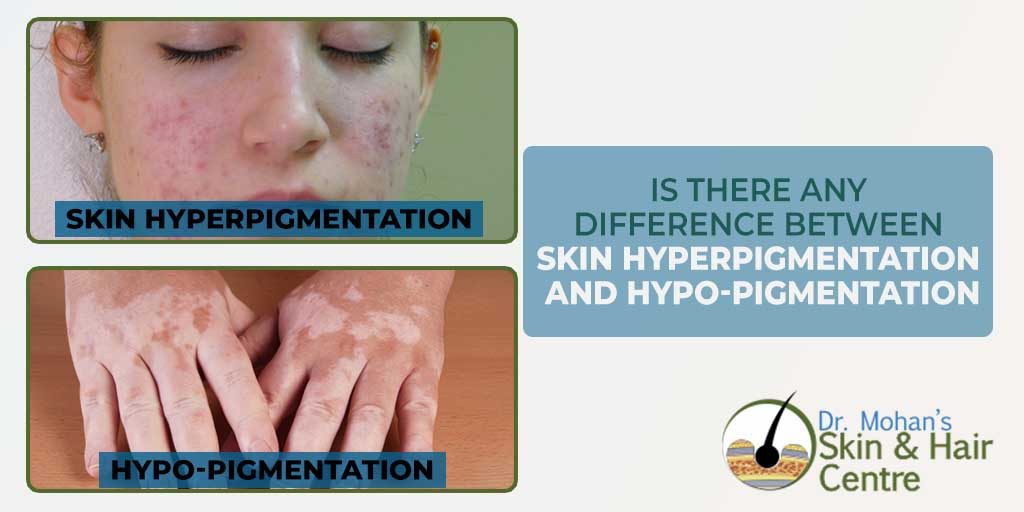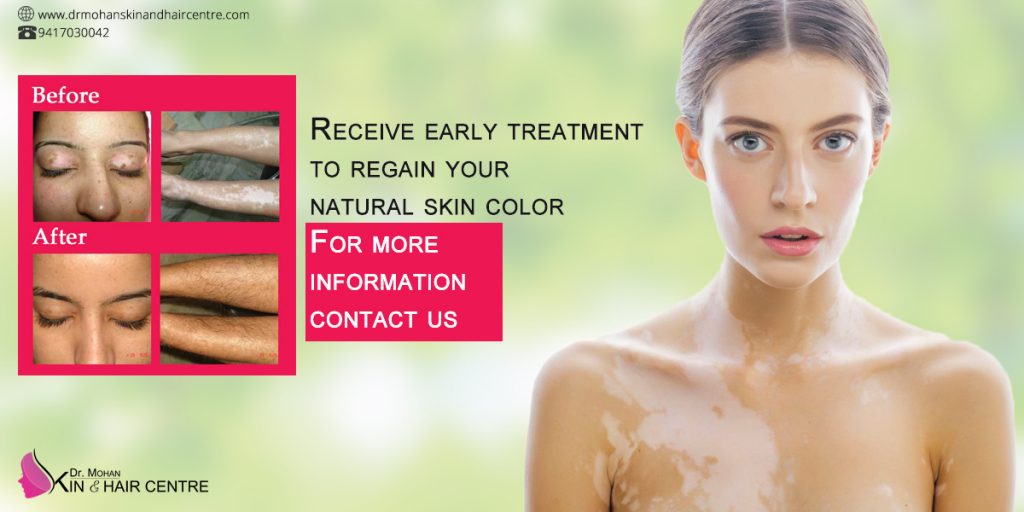Vitiligo Treatment in India

What Does Vitiligo Mean?
Vitiligo is a skin condition where white patches (Segmental or Non-segmental) develop on the skin. Worldwide, there are thousands of individuals diagnosed and living with vitiligo and significantly differs with its skin coverage in individuals…
More
Vitiligo generally causes an abnormal skin pigmentation in different areas of the body, such as fingers, around the eyes and lips, among other regions. The condition is triggered when one’s pigment-producing cells known as the melanocytes located in the lower layers of the epidermis of the skin are damaged.
Scientifically, the melanocytes cells produce a pigment known as melanin. This melanin pigment is responsible for giving an individual his or her natural colour. In case the cells are damaged, die, or find it hard to function as they ought to, white patches will eventually develop on the skin, a condition known as vitiligo or Leucoderma.
Each individual has a given amount of the melanin pigment, and it so happens that the higher the amount of melanin, the darker one will be and the lower the melanin pigment, the lighter one will be.
It should be noted that vitiligo isn’t a life-threatening condition, but associated with an array of psychological drawbacks and a social stigma. Timely treatment is currently the main fundamental factor for successful vitiligo treatment in India, otherwise one will find it hard to restore the skin to its original colour. It should also be noted that the extent of colour loss is unpredictable in individuals since, in some, the disease only affects localized regions, whereas, in others, it will stretch to other regions.
Where does Vitiligo occur?
Vitiligo can attack any part of the body, but common parts include the hands, fingers, around the lips, the toes, legs, genitals, the chest and the back. In critical conditions, the whole body may be affected, leaving one hopeless.
Cases of severe vitiligo are triggered by genetic factors, but more patients are battling the same problem due to sun exposure, burns, and autoimmune diseases.
Vitiligo is generally a long-term skin condition in which the skin will continuously lose its melanin pigment and develop white patches. It affects all age groups, genders and ethnic groups or nationalities.
Types of Vitiligo
There are typically two types of Vitiligo which are Segmental Vitiligo and Non-Segmental Vitiligo
SEGMENTAL VITILIGO
1. This type of Vitiligo is not connected to Thyroid issues or autoimmune disorders. It is where depigmentation occurs in one area of the body and it is common in children.
2. This type can effectively be treated if caught at an earlier stage
3. Segmental Vitiligo is also common in relatively younger age groups and tends to spread rapidly in case left untreated.
4. It is not symmetric and happens to attack skin regions that aren’t exposed or seen by others.
NON-SEGMENTAL VITILIGO
1. This is mainly due to the autoimmune loss of Melanocytes which are responsible for producing melanin to give the skin its natural and normal color. It is generally described as a depigmented skin lesion condition brought about by genetic factors or environmental factors
2. This type of vitiligo can affect the whole body and is hardly treated. It will require intense treatments to at least achieve minimal results
3. It is more symmetrical and can attack all individuals (all age groups) and it is quite noticeable. In addition, it tends to attack similar body regions; that is to say, it case white patches develop on the right hand, in no big time, they will also develop on the left hand.
4. This vitiligo type is more generalized commonly classified in different categories such as Universal Vitiligo, Acrofacial Vitiligo, Generalized Vitiligo, and Mucosal Vitiligo
Causes of Vitiligo
Genetic factors- where any family member suffered from the skin problem, there are greater chances that any other person may suffer from it too
Inflammation that leads to destruction of melanin- Melanin is a pigment that gives each one of us his or her own skin color and when there any unfavorable occurrence in the body, they can be damaged hence causing patches
What Causes Vitiligo?
Vitiligo causes differ from one individual to another, but are basically categorized under; genetic causes, environmental causes, medical causes, and autoimmune causes
Genetic Causes of Vitiligo
In some cases, vitiligo manages to pass on to the next generation through genes, therefore, you may have increased chances of developing vitiligo in case your some of your family or clan members suffered from it.
Medical Causes
Nerve damage or disorders triggered by certain diseases such as diabetes can lead to vitiligo. Studies indicate that segmental vitiligo is a common type caused by nerve damage or disorders.
Autoimmune Causes
The defensive mechanism of your body lies in the immune system. Cases where your immune system isn’t functioning as it ought to, it can easily attack the normal cells (melanocytes) responsible for melanin production which directly results in vitiligo
Environmental Causes
Chemical exposure from factories, sunburn, and skin allergies can also trigger vitiligo.
Treating Vitiligo with Melanocyte Transplantation
How We Treat at Ms&HTC
It has surpassed skin grafting and it is a surgical procedure used to treat Vitiligo, pigment loss, and Leucoderma.
Initially, the procedure required a dermatologist to extract Melanocytes from the normal part of the skin and then cultured for a period of time in the laboratory. They were then transplanted to the de-pigmented region to recover the normal skin color.
With the advancement of surgical treatments, Melanocytes responsible for producing melanin are transferred from the normal area to the affected area within two hours or three and a half. The latest treatment methods like Melanocyte Transplantation have eased the mode of treatment
Before the treatment
A consultation is carried out at Mohan Skin Disease Hospital to examine patients with their different Vitiligo problems. Treatment is administered or performed as per the extent of the threat. The part to be treated will be protected using bandage for at least 6 days
Candidates for Melanocyte Transplantation
Normally, they are grouped into two categories, those with;
- Stable Vitiligo- these must have endured vitiligo for at least 8 months or more. It is good to observe that it doesn’t change with time or increase in size
- Leucoderma patients- this may be due to effects of laser tattoo removal, piebaldism, or dischromia on the burns can also undergo Melanocyte transplantation.
After the treatment
- Bandage will be applied to the treated region
- Some patients experience pain and pain killers can be used in that case.
- There will be bruising, swelling and redness
- The bandage will then be removed after a few days

Vitiligo Specialty Centre

More than 20 years experience

World wide coverage

Repigmentation is oboserved

Natural transformation
Vitiligo Treatment in India by Melanocyte Transplantation

Other Possible Vitiligo Treatments in Punjab
Skin Grafting
This technique requires great skills to avoid major scarring and other complications. Split-thickness grafts are performed as the doctor may find necessary
Epidermal Grafting
A blister is produced in the normal region and then transferred to the affected region after intensive cleaning of the skin. This method is time-consuming, meaning that it is suitable in case of small damaged regions
Side-effects of some treatments
Mainly there will be bruising and swelling after any Vitiligo treatment. This disappears after a while. Some treatments like skin grafting may result in scars, so a patient must be aware of the treatment options.
Infections are rare, but antibiotics are used to prevent or treat them
Due to his incomparable and distinctive experience in treating Vitiligo, Dr. Mohan Singh has treated countless Vitiligo patients from America, Europe, Asia, and Africa. That is basically because he knows how to treat each vitiligo case accordingly and such experience is rare in the entire world.
Is Vitiligo Making Your Life a Living Hell?
Specialized Vitiligo Treatments at Our Centre, Contact us for the Best Vitiligo Treatments in Jalandhar
Stay Young!
Explore Vitiligo FAQ’s
There is a difference between vitiligo and Leucoderma and according to skin experts, vitiligo is a long-term skin condition triggered by hormonal imbalances, genes, autoimmune conditions, prolonged emotional trauma, whereas Leucoderma is generally triggered by physical trauma. The two skin conditions may seem hard to be differentiated by an individual, but a dermatologist can easily identify one from another. With Leucoderma, an individual will generally witness de-pigmentation in localized regions and the affected spots are closely bound to the skin. With Vitiligo, it tends to be aggressive and can develop without battling a medical condition in the past.
Any extent of vitiligo attack requires a dermatologist or a skin specialist since the skin condition is typically aggressive in nature. In addition, a number of vitiligo treatments tend to have unpredictable results and serious side effects.
In the real sense, many patients have failed to effectively treat vitiligo with their own treatment approaches due to failure to identify the type and the right treatment approach. An experienced skin specialist or a dermatologist will certainly help you eliminate the condition.
A percentage of vitiligo victims have been diagnosed with genetically triggered vitiligo. This means that vitiligo can spread to the next generation or can spread from one family to another. The bad news is that there is no way of hindering vitiligo from being passed on to the fetus unless the latest IVF procedures like PGD and PGS are conducted.
Vitiligo treatments are basically categorized under oral medications, therapies, and surgeries. The best or suitable vitiligo treatment is determined by the extent of the vitiligo attack and the age of the patient. Only a dermatologist can help you prescribe the best vitiligo treatment option, hence the need for an evaluation and a comprehensive diagnosis. In addition to the given treatment approach, a number of home remedies and lifestyle changes can help a patient improve his or her skin aesthetic concerns.
Failed Vitiligo treatments are common and many in general, especially with genetics triggered vitiligo. Wrong approaches and treatments are the main hindrances to overcoming vitiligo in patients.
Any vitiligo treatment poorly performed or conducted after less observation and examination can reduce the chances of effective treatment. Treatments conducted by an inexperienced doctor can also reduce the chances. Meet Dr. Mohan to examine and devise the best treatment for you
Posts you may like
What are the common signs of Vitiligo shared by skin care specialists?
Vitiligo affects around 0.5% to 2% of people all over the world. No doubt, the condition is rare, and some people have not even heard of it. Undergoing the viti...
What are the best treatment options for treating vitiligo successfully?
Many times patients are told that there is no treatment for vitiligo. Well, that’s not true but there are treatment options. The latest vitiligo treatment in...
Things that can cause Vitiligo
Vitiligo is a long-term problem that results in loss of skin color in patches. The problem can affect people of any gender or age. All over the world, around 0....
Alternative Treatments for Vitiligo
Vitiligo is an autoimmune problem in which the skin pigment cells are destroyed which results in white patches on the skin. People who suffer from this conditio...
Causes of White Spots on Face
Many people experience skin discoloration specifically on the face. In some cases, with age people develop dark age spots. Sometimes the spots cover a large are...
Facts Related to Vitiligo
Vitiligo condition is referred to as a skin disorder that is experienced by almost 30% of people across the world. We know that it is too difficult to tell the...
Was Michael Jackson Suffering From Vitiligo?
Vitiligo is the white patches problem, which is usually caused genetically. This happens because of the loss of pigment in the skin, which gives color to the sk...
Explanation : Vitiligo In Teenagers
Vitiligo is not a common problem, this is experienced by only a few people across the world. This condition is also experienced by teenagers due to several fact...
Vitiligo : is it genetic?
Vitiligo is not a common problem, this is experienced by a small number of people. Well, this is completely a genetic condition, which leads you to several othe...
Does Vitiligo Increases The Risk of Skin Cancer?
Vitiligo is a skin problem which starts forming white patches on different parts of the body. This is an autoimmune disease which means the body starts attackin...
What Are Some Possible Risk Factors Of Vitiligo?
What is Vitiligo? Vitiligo is a problem in which patches start appearing on different parts of the body which include eyes, inside the mouth, and the hair. This...
Does Vitiligo Always Spread?
Vitiligo is a problem in which patches start appearing on different parts of the body such as eyes, inside the mouth, and the hair. This problem happens when th...
Myths And facts related Vitiligo
Myth1-: Consumption of certain foods cause vitiligo Fact-: Many people consider it as a fact but this is only an assumption and myth because no such food can ca...
Types of Vitiligo And Treatments Available
In case your skin has white patches of depigmentation, it could be a sign of Vitiligo. Vitiligo is a condition which appears when the epidermal-cell in the sk...
FAQ About Vitiligo (White Spots)
What is Vitiligo? Vitiligo is a skin disorder which causes loss of color of skin. Hence, white patches start appearing on the skin and also grow on different bo...
Can Vitiligo Go On Its Own?
Vitiligo is a condition when the color of skin appears white or patches start cropping up on the skin. The reason is still unknown, but it can affect people of...
How Can You Naturally Cure Vitiligo?
Vitiligo damages the cells present in the body known as Melanin Pigment cells. Because of Melanin, the skin color is what it is. If melanin is absent in body pa...
ਫੁਲਵਹਰੀ (ਸਫੇਦ ਦਾਗ) ਕੀ ਹੁੰਦੀ ਹੈ ਅਤੇ ਇਸਦਾ ਸਭ ਤੋਂ ਵਧੀਆ ਇਲਾਜ
ਫੁਲਵਹਰੀ ਇਕ ਚਮੜੀ ਦਾ ਰੋਗ ਹੈ ਜਿਸ ਵਿਚ ਮਰੀਜ਼ ਦੇ ਸ਼ਰੀਰ ਉਪਰ ਸਫੇਦ ਰੰਗ ਦੇ �...
Vitiligo Treatment in Ludhiana, White Patches Treatment in Ludhiana
Vitiligo is the condition of skin in which the infected person loses the blotches of colors with the unpredictable extent and rate of color loss. This condition...
Is It Obvious That Vitiligo Patients Develop Skin Cancer?
To be certain, patients with vitiligo will in one way or another express their worry about skin cancer. Although vitiligo is a complicated disease and dislikabl...
The Mystery of Vitiligo & Garlic: Could This Be A Stepping Stone To Eliminate the Skin Disorder?
Vitiligo affects people regardless of their colour, ethnicity, nationality or beliefs. The skin condition is common in all age groups including children. Vitili...
Vitiligo: Self-Esteem & Confidence Matters
Vitiligo is actually more than hypopigmentation or the mere development of white spots on the skin. Any of these skin conditions can easily fade with time, but...
Is There any Difference Between Skin Hyperpigmentation and Hypo-Pigmentation
We are certainly defined by the appearance of the skin and with that matter, every slight change or irregularity is a concern. Whether a male or a female, a cle...
White Spots in Children- Effective Ways to Eliminate them from the Skin
Your child’s skin is extremely delicate and having to deal with any skin condition at such a tender age might be the hardest experience for a parent. However,...
What are the Various Treatments for the Vitiligo?
Vitiligo is the constant epidermis problem which can be best demonstrated with the de-pigmentation of the epidermis. This disease is caused by the reduction of...
Vitiligo Diet – How it helps to cure the Vitiligo?
Vitiligo is the skin condition in which certain areas of the body lose the pigmentation and turn white. Vitiligo diet plays the vital role in curing the vitilig...
What Are The Different Types Of The White Spots?
There are some people who experience white spots on their face. Sometimes, these white spots are also appearing on the chest and the arms. White spots are norma...
Vitiligo – Symptoms, Causes, And Treatment
VITILIGO PROBLEM VITILIGO is the long-term problem with growing patches. In this disease, your skins lose the color of the skin. It can affect the people of any...
What a wonderful dermatologist!
Doctor Mohan has been my dermatologist for almost a decade now. He is now a family dermatologist since my children and anyone related to me ends up in his hospi...






